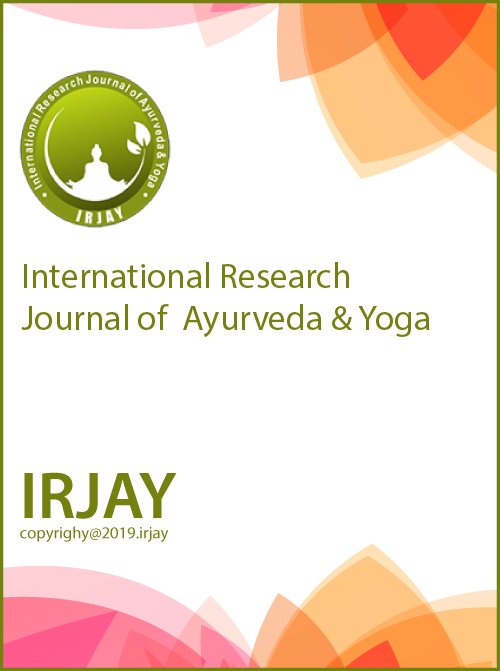An Ayurvedic Approach to Generalized Anxiety Disorder: A CaseStudy
DOI:
https://doi.org/10.48165/IRJAY.2025.80409Keywords:
Ayurveda, Chittodvega, Generalized anxiety disorder, Shamana ChikitsaAbstract
Generalized anxiety disorder is a common and disabling disorder characterized by persistent worrying, anxiety symptoms, and tension about a variety of everyday problems for a period of at least 6 months. The symptoms of this disease show resemblance with the Chittodwega (~excited state of mind) which is one among the Manovikara (~mental disorders) explained in Ayurvedic texts. According to the World Health Organization, the estimated prevalence of generalized anxiety disorder is 4%. Generalized anxiety disorder is diagnosed twice as frequently in women as men. To address this issue and reduce the need for allopathic medications with their potential adverse effects, an approach based on Ayurvedic principles is beneficial. A 53-year-old female patient came to the outpatient department of Kayachikitsa presented with complaints of insomnia, sudden feeling of warmness and coldness, giddiness, headache, burning chest, overthinking and negative thoughts, tinnitus, discomfort in crowded places, intolerance of loud noise, and constipation. The treatment protocol implemented during the patient’s first visit involved only Shamana Chikitsa (~pacifying therapy) including Anulomana (~promoting downward movement of doshas), Deepana (~appetizer), Pachana (~digestive), and Medhya (~nootropic) drugs. The patient was assessed for improvement in signs and symptoms after 1.5 months of treatment. The patient got significant relief in all symptoms. The Hamilton Anxiety Scale scores 29 before the treatment, later reduced to 09 after the follow-up. The present case study highlights the potential of Ayurveda intervention in the management of anxiety disorders.
Downloads
References
1. Benjamin SJ, Virginia SA, Pedro R, editors. Kaplan and sadock synopsis of psychiatry. 11th ed. Philadelphia, PA: Wolters Kluwer; 199. p. 408.
2. Niraj A, editor. A short textbook of psychiatry. 7th ed. New Delhi: Jaypee Brothers Medical Publishers(P)Ltd.; 2011. p. 89.
3. Benjamin SJ, Virginia SA, Pedro R, editors. Kaplan and sadock synopsis of psychiatry. 11th ed. Philadelphia, PA: Wolters Kluwer; 199. p. 407.
4. American Psychiatry Association. Diagnostic and statistical manual of mental disorders. 5th ed. Washington, DC, London, England: American Psychiatry Publishing; 2013. p. 225.
5. Trikamji Y, editor. Charaka samhita of agnivesha, sutrasthana; Maharoga adhyaya. Ch. 20., Verse 11. Varanasi: Chaukhamba Surabharati Prakashan; 2015. p. 113.
6. Trikamji Y, editor. Charaka samhita of agnivesha, chikitsasthana; Rasayanadhyaya. Ch. 1., Verse 7. Varanasi: Chaukhamba Surabharati Prakashan; 2015. p. 386.
7. Hamilton M. The assessment of anxiety states by rating. Br J Med Psychol. 1959;32:50-5.
8. Spitzer RL, Kroenke K, Williams JB, Lowe B. A brief measure for assessing generalized anxiety disorder: The GAD-7. Arch Internal
Med. 2006;166:1092-7. doi: 10.46607/iamj07p6052022
9. Trikamji Y, editor. Charaka samhita of agnivesha, sutrasthana; Tistraishaniya adhyaya. Ch. 11., Verse 46. Varanasi: Chaukhamba Surabharati Prakashan; 2015. p. 88.
10. Trikamji Y, editor. Charaka samhita of agnivesha, sustrasthana; Tistraishaniya adhyaya. Ch. 11., Verse 54. Varanasi: Chaukhamba Surabharati Prakashan; 2015. p. 77.
11. Acharya YT. Siddha yoga sangraha. 8th ed. Nagpur: Shri Baidyanatha Ayurveda Bhavana Ltd.; 1984. p. 86.
12. Ibrahim M, Pawar G, Khan N, Gudalwar B, Khan S, Mazhar M. Therapeutic effect of Withania somnifera (Ashwagandha) on depression: A comprehensive review. Nat Resour Hum Health. 2024;4:142-151. doi: 10.53365/nrfhh/177661
13. Sheetal T, Swanand P, Nilima W, Mohan Y, Rajkumar G. Comparative study of efficacy of Jatamansi (Nardostachys jatamansi DC) and imipramine in generalized anxiety disorder (G.A.D.): A randomized controlled double blind clinical trial. J Pharm Res Int. 2021;33:132-
40. doi: 10.9734/jpri/2021/v33i63A35225
14. Singla R, Jaitak V. Shatavari (Asparagus racemosus wild): A review on its cultivation, morphology, phytochemistry and pharmacological importance. Int J Pharm Sci Res. 2014;5:730-41.
15. Trikamji Y. Amla pittadhikara, 2. Sootashekhara rasa. In: Siddha yoga samgraha. Allahabad: Shree Baidyanath Ayurveda Bhawan Ltd.; 2012. p. 47-8.
16. Government of India. The Ayurvedic Formulation of India, Part I. 2nd Revised English ed. New Delhi: Government of India; 2008. 17. Shah NC, Bhaishjayaratnavali, Amlapittadhikara, Chaukhamba Surabharati Prakashan; 2015. p. 106.


